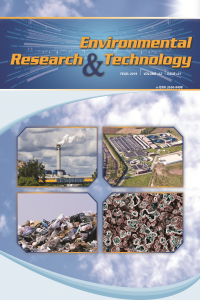Research Article
Integrated study of building information modeling (BIM) with green buildings for a sustainable environment
Abstract
This study emphasizes the necessity of sustainable buildings in order to protect environmental resources and reduce pollution by using technological developments. With the building information modeling, which is one of the contributions of developing technology, a three-dimensional simulation of a building project can be created. The annual energy and carbon emissions of the building can be calculated by means of analysis tools. Within the scope of the study, it is emphasized that the effects of carbon emissions on window thickness, window wall ratio, and window shades can be predicted by using Building Information Modeling analysis tools.
References
- Reference1 H. Aladağ, G. Demirdögen and Z.Isık, Building Information Modeling (BIM) Use in Turkish Construction Industry, ScienceDirect, WMCAUS, Procedia Engineering 161 (2016) 174-179, Yildiz Technical University, İstanbul/Turkey.J. Breckling, Ed., The Analysis of Directional Time Series: Applications to Wind Speed and Direction, ser. Lecture Notes in Statistics. Berlin, Germany: Springer, 1989, vol. 61.
- Reference2 S. Azhar, W.A. Carlton, D. Olsen and I. Ahmad, Building Information Modeling for Sustainable Design and LEED Rating Analysis, ScienceDirect, Automation in Construction 20 (2011) 217-224, Auburn University, Florida International University, Miami/USA.
- Reference3 H.Y. Chong, C.Y. Lee and X. Wang, A Mixed Review of the Adoption of Building Information Modeling(BIM) for Sustainability, ScienceDirect, Journal of Cleaner Production 142 (2017) 4114-4126, Curtin University/Australia, Kyung Hee University/South Korea.
- Reference4 M. Yılmaz and A. Bakış, Sustainability in Construction Sector, ScienceDirect, Procedia-Social and Behavirol Sciences, World Conference on Technology, Innovation and Entrepreneurship, 195(2015) 2253-2262, İstanbul University, İstanbul/Turkey. (2007) The IEEE website. [Online]. Available: http://www.ieee.org/
- Reference5 G.D. Özperçin, Integrated Project Delivery Method Using BIM to Support of Sustainable Design and Construction, MSc. Thesis Department of Architecture Program of Housing Production and Construction Management, Yildiz Technical University,2016, İstanbul/Turkey.FLEXChip Signal Processor (MC68175/D), Motorola, 1996.
- Reference6 AUTODESK Sustainability Workshop website. [Online]. Available: https://sustainabilityworkshop.autodesk.com/building-design/concepts
- Reference7 AUTODESK Revit website. [Online]. Available: https://www.autodesk.com/products/revit-family/overview
- Reference8 AUTODESK FormIT website. [Online]. Available: https://www.autodesk.com/products/formit/overview
- Reference9 AUTODESK Insight 360 website. [Online]. Available: https://www.autodesk.com/products/insight/overview
- Reference10 AUTODESK Green Building Studio website. [Online]. Available: https://gbs.autodesk.com/GBS/Project
Year 2019,
Volume: 2 Issue: 1, 46 - 54, 31.03.2019
Abstract
References
- Reference1 H. Aladağ, G. Demirdögen and Z.Isık, Building Information Modeling (BIM) Use in Turkish Construction Industry, ScienceDirect, WMCAUS, Procedia Engineering 161 (2016) 174-179, Yildiz Technical University, İstanbul/Turkey.J. Breckling, Ed., The Analysis of Directional Time Series: Applications to Wind Speed and Direction, ser. Lecture Notes in Statistics. Berlin, Germany: Springer, 1989, vol. 61.
- Reference2 S. Azhar, W.A. Carlton, D. Olsen and I. Ahmad, Building Information Modeling for Sustainable Design and LEED Rating Analysis, ScienceDirect, Automation in Construction 20 (2011) 217-224, Auburn University, Florida International University, Miami/USA.
- Reference3 H.Y. Chong, C.Y. Lee and X. Wang, A Mixed Review of the Adoption of Building Information Modeling(BIM) for Sustainability, ScienceDirect, Journal of Cleaner Production 142 (2017) 4114-4126, Curtin University/Australia, Kyung Hee University/South Korea.
- Reference4 M. Yılmaz and A. Bakış, Sustainability in Construction Sector, ScienceDirect, Procedia-Social and Behavirol Sciences, World Conference on Technology, Innovation and Entrepreneurship, 195(2015) 2253-2262, İstanbul University, İstanbul/Turkey. (2007) The IEEE website. [Online]. Available: http://www.ieee.org/
- Reference5 G.D. Özperçin, Integrated Project Delivery Method Using BIM to Support of Sustainable Design and Construction, MSc. Thesis Department of Architecture Program of Housing Production and Construction Management, Yildiz Technical University,2016, İstanbul/Turkey.FLEXChip Signal Processor (MC68175/D), Motorola, 1996.
- Reference6 AUTODESK Sustainability Workshop website. [Online]. Available: https://sustainabilityworkshop.autodesk.com/building-design/concepts
- Reference7 AUTODESK Revit website. [Online]. Available: https://www.autodesk.com/products/revit-family/overview
- Reference8 AUTODESK FormIT website. [Online]. Available: https://www.autodesk.com/products/formit/overview
- Reference9 AUTODESK Insight 360 website. [Online]. Available: https://www.autodesk.com/products/insight/overview
- Reference10 AUTODESK Green Building Studio website. [Online]. Available: https://gbs.autodesk.com/GBS/Project
There are 10 citations in total.
Details
| Primary Language | English |
|---|---|
| Subjects | Environmental Engineering |
| Journal Section | Research Articles |
| Authors | |
| Publication Date | March 31, 2019 |
| Submission Date | June 20, 2018 |
| Acceptance Date | January 22, 2019 |
| Published in Issue | Year 2019 Volume: 2 Issue: 1 |


